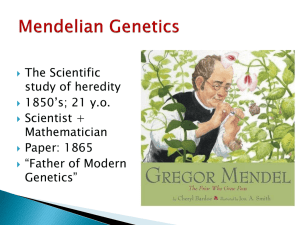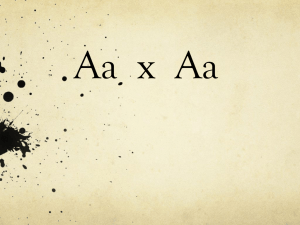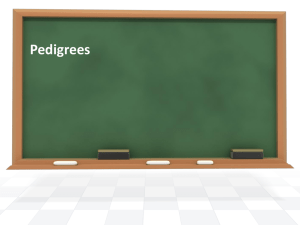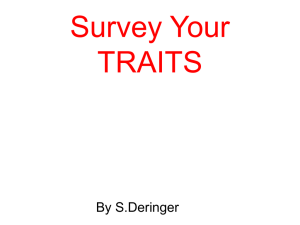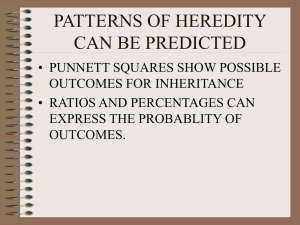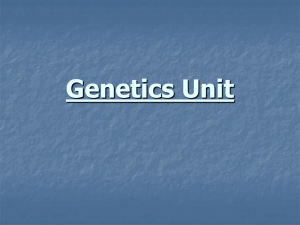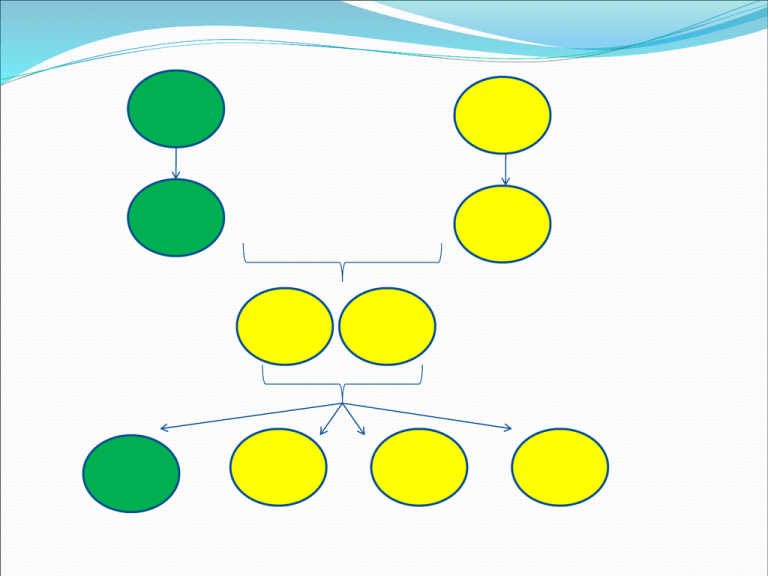
Genetics
• Study of inheritance, the stability
•
•
•
•
and variance of inheritance
patterns
Gregor Mendel, “The Father of
Genetics”
Worked with the garden pea plant
using cross pollination
What would happen if we all had
the exact same DNA sequences?
What if we had extremely
divergent DNA sequences?
What determines which genes we
inherit from our mother and
father?
Genetic Terms
Gene-basic unit of inheritance, arranged in a linear sequences on a
chromosomes
Allele-alternative forms of a gene; alleles contain genetic information that
is expressed as traits.
Examples of traits are flower color, seed shape, plant height etc.
Each trait can have a different version (allele); flower color can be purple
or white, we use one letter for the trait flower color, but change whether it
is upper or lower case
Genetic Terms
• Dominant- 1 copy of allele
results in expression of
trait, always use a capital
letter to show it is
dominant, ex. A
• Recessive-requires 2
copies of same allele to get
expression of trait, always
use lower case letter to
show it is recessive, ex. a
• If purple is dominant to
white flowers, how would
you write your alleles?
Genetic Terms
Homozygous Dominant-2 same copies of dominant allele,
get expression of dominant trait, AA
Heterozygous Dominant-1 copy of dominant allele, 1 copy
of recessive, still get dominant trait expression, Aa
Homozygous recessive-2 copies of recessive allele, get
expression of recessive trait, aa
Genetic Terms
• Genotype-genes of an organism
• Phenotype-physical appearance of the organism
True or False: The phenotype of an organism is
dictated by the genotype of that organism
• True breed lineage vs. hybrid offspring
• P, F1, F2 Generation
Genetic Terms
Monohybrid cross-a cross that only predicts the
genotype and phenotype for one trait, ex. plant flower
color
Dihybrid cross-a cross that predicts the genotype and
phenotype of 2 traits, ex. plant flower color and height
Predicting Gametes
If an organism has the genotype BB, how many
different gametes can it make? 1: B
When predicting gametes, keep in mind that
each gamete must have 1 complete set of
instructions
Cc
2: C, c
DDEE
1: DE
KKLlMM
2
TTUUVV
1
GgHh
4: GH, Gh, gH, gh
AaBBCc
4
Mendel’s Early Genetic Experiments:
Monohybrid Cross
Crossed a true breed purple flower plant with a true
breed white flower plant
P generation
PP x pp
P-purple
p-white
Pp
F1 generation, all purple heterozygous dominant
Crossed the F1 generation with each other
Pp x Pp
F2 generation
PP, Pp, Pp, pp
Genotypic Ratio 1 PP: 2 Pp :1 pp
Phenotypic Ratio 3 purple: 1 white
Mendel’s Law of Segregation
Mendel continued his monohybrid
crosses (1000s) for 7 different traits
Average ratio for all traits studied
was always about 3:1
The Law of Segregation:
Each individual has 2 of every
gene (alleles) for each trait
These genes (alleles) will
separate from each other during
meiosis into different gametes.
Fertilization gives each new
individual 2 alleles for each trait
A
a
b
B
A
A
B
b
a
B
a
b
Genetics Problem
In parrots, alleles for blue feathers are dominant to
alleles for yellow.
Cross a heterozygous dominant blue feathered parrot
with a yellow feathered parrot
b
b
B
b
Bb
bb
Bb
bb
Genotypic ratio 1 Bb : 1 bb
Phenotypic ratio 1 Blue : 1 yellow
Genetics Problem
Rhinoceroses can be born without a horn, the recessive
condition.
Cross 2 heterozygous dominant rhinoceroses. Can they
produce a baby rhino without a horn?
H-horn present
h-no horn
H
h
H
HH
Hh
h
Hh
hh
Genotypic Ratio 1 HH: 2 Hh : 1 hh
Phenotypic Ratio 3 with horns : 1 no horn
Mendel’s Early
Genetic Experiments:
Dihybrid Cross
• Mendel noticed that all
purple flower plants were
tall and all white flower
plants were short
• Could you ever see a
purple short plant or a
white tall plant?
• Crossed a homozygous
dominant tall purple
flower plant with a
homozygous recessive
short white flower plant
P generation
AABB x aabb
F1
AaBb
F2
AaBb x AaBb
4 by 4 punnett square
Phenotypic ratio 9 purple, tall: 3 purple, short: 3 white, tall: 1 white, short
Mendel’s Early Genetic Experiments:
Principle of Independent Assortment
• The results from the many
dihybrid crosses allowed
him to develop the
• Principle of
Independent
Assortment-gene pairs
(traits) are independent of
each other and are sorted
into different gametes
• Exception: Linked genes;
they always sort together
into same gamete
A
a
b
B
Diploid
(2N)
A
A
B
b
Haploid
(1N)
a
B
a
b
In panthers, black fur is dominant to yellow fur.
A recessive gene results in the absence of claws.
Predict the offspring of a cross between a
heterozygous black panther with no claws and a
yellow panther that is heterozygous for claws
B-black fur
C-claws
b-yellow fur
c-no claws
bC
bc
Bc
BbCc
Bbcc
bc
bbCc
bbcc
Genotypic Ratio 1:1:1:1
Phenotypic Ratio 1:1:1:1
Punnett Square and Probabilities
• What is the probability
from the following
cross that any offspring
will have unattached
earlobes or attached
earlobes?
• The probability of
inheriting a specific
allele is like flipping a
coin and occurs every
time parents have an
offspring
Mendel’s Early Genetic Experiments: Test
Cross
If you have a purple flower, what are
the possible genotypes?
PP or Pp
How do you decide? Do a Test Cross
using a white flower plant
PP x pp = all offspring are Pp (purple)
Pp x pp = ½ offspring are Pp (purple)
½ offspring are pp (white)
Human Genetics
The study of inheritance and prediction of genes in
humans
Very difficult, many genes involved
Small sample size, few offspring
Mate by chance, live in diverse environments
Long life span makes it difficult to track genes in
different generations
Human Genetics: Understanding a Pedigree
Pedigree-a chart of genetic connections between individuals;
family tree that tracks genes/diseases
Single genes can be followed by constructing pedigrees
Square=male
circle=female
Shaded =affected
non-shaded=not affected
A line between a circle + square=mating
Lines from the mating=offspring
Human Inheritances Patterns
• Autosomal Recessive
Inheritance-gene is
located on autosome; 2
copies of gene required for
expression of disease/trait;
1 copy=carrier, not affected
• Albinism, cystic fibrosis,
sickle cell anemia,
phenylketonuria,
methemoglobinemia,
Niemann-Pick disease
Effects of Autosomal Recessive
Disorders
F-normal, no cystic fibrosis
f-cystic fibrosis
What are the chances of offspring from 2
heterozygote parents for the cystic fibrosis
gene having the disease?
Parents are carriers
F
F
f
f
FF
Ff
Ff
ff
25% (1 out of 4) will have cystic fibrosis
What are the genotypic/phenotypic ratios?
Human Inheritances Patterns
• Autosomal dominant
inheritance- gene is
located on autosome; 1
copy of gene results in
expression of
disease/trait
• Ex. Achondroplasia,
Huntington’s,
Osteogenesis
Imperfecta,
polydactyly, progeria,
sperocytosis
P-polydactyly (extra fingers/toes)
p-normal
What are the chances of offspring from a
cross of 2 heterozygous parents for
polydactyly also having the condition?
P
p
P
PP
Pp
p
Pp
pp
75% (3 out of 4) chance of having polydactyly
What is the genotypic/phenotypic ratios?
Variations to Mendelian Inheritance
Patterns: Multiple Alleles
Codominance
2 alleles are not dominant to each other, and if both
are present both are expressed
Ex. Blood Groups- ABO blood typing
A dominant to O, but not to B
B dominant to O, but not to A
O recessive
Codominance: Blood Typing
There are 6 genotypes that express 4 different blood
phenotypes
Phenotype
Type A
Type B
Type AB
Type O
Genotype
AA, AO
BB, BO
AB
OO
Codominance: Blood Typing
What does a blood typing do? Why is blood called A,
B, AB, or O?
Based on the different sugars found on red blood cells
ex. Type A blood has A sugars on RBCs
What type of sugars does AB or O have?
Why do we need to type blood?
Codominance: Blood Typing Problems
Cross a person with type O blood with one that has
type AB blood
Give phenotypic and genotypic ratios
O
O
A
AO
AO
B
BO
BO
Genotypic Ratio 1 AO : 1 BO
Phenotypic Ratio 1 Type A : 1 Type B
Type B blood male and a Type O blood female never
produce a Type O blood child.
Is this possible? Why or why not?
Type B blood can be BB or BO*
O
O
B
BO
BO
B
BO
BO
Genotypic Ratio
All are BO
Phenotypic Ratio All are Type B
*this genotype would produce a Type O
offspring
If father’s genotype is BO, it would be
possible to get an O blood type child
O
O
B
O
BO OO
BO OO
Genotypic ratio: 1 BO: 1 OO
Phenotypic ratio: 1 type B: 1 type O blood
Variations to Mendelian
Inheritance Patterns
• Incomplete Dominance-one
allele isn’t complete dominant
to the other; heterozygotes are
intermediate in phenotype
• Snap dragon flower color: R-red,
r-white
• RR x rr = Rr all offspring are
pink
• What happens when 2 pink
flower plants are crossed? Give
phenotypic and genotypic ratios
Rr
Rr
R-red
r-white
Rr-pink
R
r
R
RR
Rr
r
Rr
rr
Pleiotropy
• Expression of alleles (for 1 trait) has positive or
negative effects on other traits Ex. Sickle cell mutation
• Affects the protein hemoglobin which carries O2
• Insufficient O2 will cause RBCs to sickle and
eventually burst anemia
• Secondary effectsheart/lung damage, kidney/heart
failure, skull deformation, mental impairment
Pleiotropy: Marfan Syndrome
Single gene mutation affects 2 or more distinct and unrelated
traits
mutation of fibrillin gene
Incomplete Penetrance
Polydactyly extra fingers/toes
Autosomal dominant disorder which exhibits
incomplete penetrance
A dominant allele sometimes does not determine the
phenotype
Some who inherit polydactyly allele are phenotypically
normal
Pleiotropy: Sickle Cell Anemia
• Homozygous for condition die in early
40s, no cure, extremely debilitating
• Severe anemia, poor circulation,
physical weakness, impaired mental
function, spleen damage
• Why is this mutation maintained?
• Protection/resistance against malaria
S-no sickle cell
s-sickle cell (recessive)
• SS-no sickle cell, no resistance
• Ss-no sickle cell, resistance Heterozygote advantage
• ss-sickle cell, resistance
Cross 2 heterozygous dominant parents together.
How many children would have sickle cell?
How many children would not?
How many children are resistant to malaria? How
many are not?
Parents are Ss-do not have sickle cell
S
s
S
SS
s
Ss
Ss
ss
3 children do not have sickle cell, 1 does
3 children protected, 1 is not
Epistasis
• When one gene pair masks/prevents another gene
pair’s expression
Ex. Labrador fur color
• B-black fur
b-brown fur
• E-melanin deposited
e-no melanin
• The recessive genotype of “ee” will cause no melanin
deposition, thus the resulting fur coat will be yellow,
even when “B or b” alleles are present
Continuous Variation in
Traits
• Multiple genes are responsible
•
•
•
•
for the phenotype of an
organism polygenic
inheritance
Skin and eye color, height
A great deal of variation exists
resembling a bell shaped curve
Look at human height; a few
genes regulate height, but there
exists a normal amount of
variation
What factors contribute to
height?
Environmental Effects on Phenotype:
Multifactorial Traits
Fur color on Siamese cats or Himalayan
rabbits-heat sensitive enzyme that produces
melanin
Flower color on Hydrangea Plant-influenced
by acidity of soil
Height of Yarrow plant cuttings-varies
depending on elevation planted
Continuous Variation in Traits
Genetics allows us to predict genotypes of organisms, but
there are many external and internal factors that influence
the actual phenotype of those organisms cleft lip/palate,
clubfoot, hypertension, diabetes, schizophrenia, allergies,
cancers
An individual’s phenotype is the outcome of the
complex interaction among all its genes and
environment in which it lives
G x E interaction
Sex Determination in Humans
Determined by the 23rd pair on chromosomes
XX-female
XY-male
A female only makes eggs that carry the X
chromosome
A male makes sperm that contain either the X or Y
chromosome
Males are haploid for the X chromosome, females are
diploid
Sex Determination in Humans
• Sex is determined by the Y chromosome
• Up until about 7 weeks, an embryo has a
•
•
•
•
uncommitted reproductive duct system
This duct system will develop into testes/penis if a Y
chromosome is present
This is due to the expression of the SRY gene located
on the Y chromosome
No Y chromosome duct system forms into
ovaries/uterus
Faulty SRY phenotypic female, sterile
Human Inheritance Patterns
• X-linked recessive-gene is
located on the X
chromosome; 2 copies of
gene required for expression
in females, 1 copy in males
results in expression. XX vs
XY
• Ex. Fragile X syndrome,
hemophilia, color blindness,
muscular dystrophy,
Menkes syndrome,
adrenoleukodystropy
X-linked Recessive Inheritance
Problem
What type of offspring would a colorblind man and
woman who is a carrier for CB have?
Female-Cc not colorblind
Colorblind male-c
But CB is X-linked XCXc
Xc
XC
Xc
XcY
Y
XCXc
XCY
XcXc
XcY
Female offspring ratio 1 CB: 1 no CB
Male offspring ratio 1 CB: 1 no CB
X-linked Recessive Inheritance
Problem
Can a female with muscular dystrophy ever have a son
who does not have MS?
Can a male with hemophilia have a daughter who is
not affected with the disease?
M-no MS
m-has MS
XM
XMXm
Y
XmY
Xm XmXM
XmY
Xm
No, all male offspring would have MS
H-no Hemophilia
h-Hemophilia
XH
XH
Xh
Y
XHXh
XHY
XHXh
XhY
Yes, female offspring would not have
hemophilia, but are carriers for the gene



